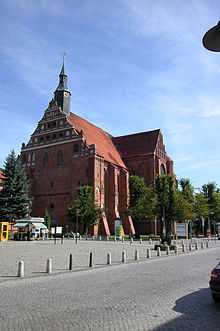Bad Wilsnack
| Bad Wilsnack | ||
|---|---|---|
| ||
 Bad Wilsnack | ||
Location of Bad Wilsnack within Prignitz district  | ||
| Coordinates: 52°57′00″N 11°56′59″E / 52.95000°N 11.94972°ECoordinates: 52°57′00″N 11°56′59″E / 52.95000°N 11.94972°E | ||
| Country | Germany | |
| State | Brandenburg | |
| District | Prignitz | |
| Municipal assoc. | Bad Wilsnack/Weisen | |
| Subdivisions | 8 Stadtteile | |
| Government | ||
| • Mayor | Dietrich Gappa (CDU) | |
| Area | ||
| • Total | 79.21 km2 (30.58 sq mi) | |
| Elevation | 27 m (89 ft) | |
| Population (2012-12-31)[1] | ||
| • Total | 2,612 | |
| • Density | 33/km2 (85/sq mi) | |
| Time zone | CET/CEST (UTC+1/+2) | |
| Postal codes | 19336 | |
| Dialling codes | 038791 | |
| Vehicle registration | PR | |
| Website | www.bad-wilsnack.de | |
Bad Wilsnack is a town in the Prignitz district, in Brandenburg, Germany. It is situated halfway between Berlin and Hamburg. Since 1928 it has been officially recognised as a spa town, before which time its name was simply Wilsnack. Bad Wilsnack is pronounced "But Vilsnuck".
Overview

The town became a pilgrimage destination after being burned down in the 14th century during a raid by Heinrich von Bülow. It was believed that in 1383 some hosts were found to have survived the fire, but had the appearance of being bloodied. The Holy Blood of Wilsnack was authenticated when Bishop Dietrich Man of Havelberg went to consecrate the hosts as a precaution, and the central one overflowed with blood, according to later accounts. Jan Hus and Nicholas of Cusa later discouraged pilgrimage to Wilsnack, questioning the nature of these wonder hosts and suspecting fraud.
Numerous pilgrims went to the town (which was rebuilt) to see the miraculous hosts; their revenues enabled the town to construct the large St. Nikolai Church for their worship, a larger building than otherwise needed in the parish. The pilgrims who went to Wilsnack bought pewter trinkets to indicate that they had reached the site. These emblems were often in the form of three hosts connected together. Seen in numerous medieval paintings, the tokens have turned up in archaeological digs from the area. The numbers of pilgrims were said to rival those to Santiago de Compostela in Spain. Despite controversy, the pilgrimages continued until 1558, when the hosts were destroyed during the Protestant Reformation.
The story of the bleeding hosts was depicted in a series of woodcuts made during the Middle Ages. The town used the image on emergency money which it printed and issued during the inflation crisis of the 1920s (Notgeld).
References
- ↑ "Bevölkerung im Land Brandenburg nach amtsfreien Gemeinden, Ämtern und Gemeinden 31. Dezember 2012 (XLS-Datei; 83 KB) (Einwohnerzahlen auf Grundlage des Zensus 2011)". Amt für Statistik Berlin-Brandenburg (in German). 31 December 2012.
External links
![]() Media related to Bad Wilsnack at Wikimedia Commons
Media related to Bad Wilsnack at Wikimedia Commons
| |||||||
